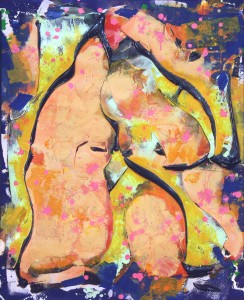
Not Your Mother’s Abstract Art
Writing about the visual arts can be a suspect exercise — how can you convey in words what is being said with image? When trying to describe abstract painting, the ground gets even shakier. But here’s an attempt, about the exhibit up at the Center for Visual Communication, “Abstract Miami.”
Abstract art is the opposite of representational, and — give or take a couple decades — a 20th-century innovation. From the French Impressionists to the Russian avant-garde, from the German Bauhaus to the American Abstract Expressionists and the New York School, it’s been a dominant movement for well over a century.
Darby Bannard was part of the later New York School, and along with friend Frank Stella was a player in the Minimalist movement. He is now chair at the University of Miami Art and Art History Department. Over the years here he has worked with local talent to develop what they are calling the Miami School of abstraction, highlighted in this exhibit.
The front room of the large space (close to the Margulies Collection) is devoted to very recent paintings from Bannard, colorful and expressive and far more reflective of his current home of Miami than of a more somber-toned New York. The same is true for many of the paintings in this show — the pastel colors can in fact be jarring for anyone expecting your mother’s abstractions.
And in fact, there are varying degrees of abstraction here. Some are more representational than others: for instance, Sean Smith’s “Fast Times” very clearly depicts a race track, the circular movement of the colors and the “road” are immediately apparent. Next to them are two eye-catching pieces made of aluminum flashing on vinyl by Andy Gambrell, which look like houses raised off the canvas but are called “Prince Myshkin” and “Rogozhin.”
There are six very large and nice paintings on one wall from a veteran of the abstract painting world here, George Bethea, interrupted by a mixed-media canvas that includes gold leaf from new graduate David Marsh.
Maybe the loveliest paintings are in the foyer, looking vaguely like satellite images, or organic matter, from Kerry Ware, all five oils on plaster panel.
In all, there are 38 paintings in the show, and with the ample space, the paintings (some very large) don’t feel too jumbled together or crowded, giving the viewer time and space to visit the quite varied 21st-century abstract work with a Miami flavor.
“Abstract Miami” through Nov. 18 at the Center for Visual Communication 541 N.W. 27th St., Miami; 305-571-1415; www.visual.org.
Recent Content
-
Artsarticle ·
-
Artsarticle ·
-
Artsarticle ·


